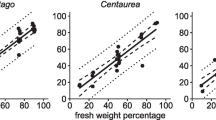Abstract
Pea plants exhibit density-dependent habitat selection as they grow. We split the root of a young pea (Pisum sativum L.) so that half grew in one pot and half in an adjacent pot. The rest of the plant remained intact. This is a ‘fence-sitter plant’. Each root-half was exposed either to no competition in its pot or to competitor plants sharing its pot. There were one, two, three or five competitor plants. The total root biomass and the fitness (= dry weight of fruit) of the fence-sitter decreased only slightly and insignificantly in response to increased density of the competitor plants. The fitness of the competing plants decreased with density. The fence-sitter shifted its root system from the pot with competition to that free of competition in proportion to the number of competitors. The fence-sitter apparently invested in each of its two roots so that the ratio between the roots was similar to the ratio between the resources in the pots. This result is analogous to the habitat-matching rule of the ideal free distribution of populations (Fretwell, 1972). We suggest that plants invest in each of their roots until the uptake rate per unit root biomass is equal for all roots.
Similar content being viewed by others
References
Campbell, B.D., Grime, J.P., Mackey, J.M.L. and Jalili, A. (1991) The quest for a mechanistic understanding of resource competition in plant communities: The role of experiments. Func. Ecol. 5, 241-253.
Charnov, E.L. (1976) Optimal foraging, the marginal value theorem. Theor. Pop. Biol. 9, 129-136.
Crick, J.C. and Grime, J.P. (1987) Morphological plasticity and mineral nutrient capture in two herbaceous species of contrasted ecology. New Phytologist 107, 403-414.
de Kroon, H. and Schieving, F. (1991) Resource allocation patterns as a function of clonal morphology: A general model applied to a foraging clonal plant. J. Ecol. 79, 519-530.
Drew, M.C. and Saker, L.R. (1975) Nutrient supply and the growth of seminal root system in barley. II. Localized compensatory increase in lateral root growth and rates of nitrate uptake when nitrate supply is restricted to only part of the root system. J. Exp. Bot. 26, 79-90.
Drew, M.C., Saker, L.R. and Ashley, T.W. (1973) Nutrient supply and the growth of seminal root system in barley. I. The e.ects of nitrate concentration on the growth of axes and laterals. J. Exp. Bot. 24, 1189- 1202.
Fagen, R. (1987) A generalized habitat matching rule. Evol. Ecol. 1, 5-10.
Fretwell, S.D. (1972) Population in a Seasonal Environment. Princeton University Press, Princeton, NJ.
Fretwell, S.D. and Lucas, H.L., Jr (1970) On territorial behavior and other factors influencing habitat distribution in birds. I. Theoretical development. Acta Biotheoretica 19, 16-36.
Gersani, M. (1985) Appearance of new transport capacity in wounded plants. J. Exp. Bot. 36, 1809-1816.
Gersani, M. and Sachs, T. (1992) Development correlations between roots in heterogeneous environment. Plant Cell Environ. 15, 463-469.
Granato, T.C. and Raper, C.D., Jr (1989) Proliferation of maize (Zea mays L.) roots in response to localized supply of nitrate. J. Exp. Bot. 40, 263-275.
Grime, J.P. (1979) Plant Strategies and Vegetation Processes, p. 222. John Wiley, Chichester.
Grime, J.P. (1988) The C-S-R model of primary plant strategies - origins, implications and tests. In Plant Evolutionary Biology (L.D. Gottlib and K.S. Jain, eds), pp. 371-393. Chapman and Hall, London.
Grime, J.P., Crick, J.C. and Rincon, J.E. (1986) The ecological significance of plasticity. In Plasticity in Plants (D.H. Jennings and A. Trewaras, eds), pp. 7-29. Cambridge University Press, Cambridge.
Hackett, C. (1972) A method of applying nutrients locally to roots under controlled conditions and some morphological effects of locally applied nitrate on the branching of wheat roots. Aust. J. Biol. Sci. 25, 1169-1180.
Harper, D.G.D. (1982) Competitive foraging in mallards: ‘Ideal free’ ducks. Anim. Behav. 30, 575-584.
Hoagland, D.R. and Arnon, D.I. (1950) The Water Culture Method for Growing Plants Without Soil. California Agricultural Experiment Station, Circular No. 374.
Jackson, R.B. and Caldwell, M.M. (1989) The timing and degree of root proliferation in fertile soil microsites for three cold-desert perennials. Oecologia 81, 149-153.
Messier, F., Virgl, J.A. and Marinelli, L. (1990) Density-dependent habitat selection in muskrats: A test of the ideal free distribution model. Oecologia 84, 380-385.
Milinski, M. (1979) Evolutionarily stable feeding strategy in sticklebacks. Z. Tierpsychol. 51, 36-40.
Morris, D.W. (1994) Habitat matching: Alternative and implications to populations and communities. Evol. Ecol. 8, 387-406.
Parker, G.A. (1978) Searching for mates. In Behavioral Ecology (J.R. Krebs and N.B. Davies, eds), pp. 214- 244. Blackwell Scientific, Oxford.
Pulliam, H.R. and Caraco, T. (1984) Living in groups: Is there an optimal group size? In Behavioral Ecology (J.R. Krebs and N.B. Davies, eds), 2nd edn, pp. 122-147. Blackwell Scientific, Oxford.
Sachs, T. (1981) The controls of the patterned differentiation of vascular tissues. Adv. Bot. Res. 9, 151-262.
Sachs, T. (1991) Pattern Formation in Plant Tissues. Cambridge University Press, Cambridge.
Salzman, A.T. (1985) Habitat selection in a clonal plant. Science 228, 603-604.
Singleton, P.W. and van Kessel, C. (1987) Effect of localized nitrogen availability to soybean half root system on photosynthate partitioning to roots. Plant Physiol. 83, 552-556.
Sutherland, W.J. and Stillman, R.A. (1988) The foraging tactics of plants. Oikos 52, 239-244.
Tilman, D. (1988) Plant Strategies and the Structure and Dynamic of Plant Communities. Princeton University Press, Princeton, NJ.
Wightman, F. and Thimann, K.V. (1980) Hormonal factors controlling the initiation and development of lateral roots. I. Sources of primordia-inducing substances in the primary root of pea seedlings. Physiologia Plantarum 49, 13-20.
Author information
Authors and Affiliations
Rights and permissions
About this article
Cite this article
Gersani, M., Abramsky, Z. & Falik, O. Density-dependent habitat selection in plants. Evolutionary Ecology 12, 223–234 (1998). https://doi.org/10.1023/A:1006587813950
Issue Date:
DOI: https://doi.org/10.1023/A:1006587813950




